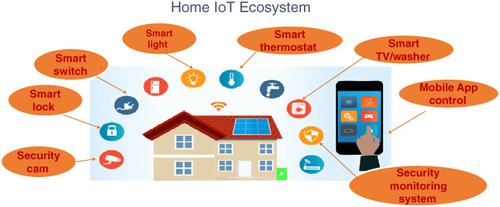当前位置:
X-MOL 学术
›
WIREs Data Mining Knowl. Discov.
›
论文详情
Our official English website, www.x-mol.net, welcomes your
feedback! (Note: you will need to create a separate account there.)
Behavioral fingerprinting of Internet‐of‐Things devices
WIREs Data Mining and Knowledge Discovery ( IF 6.4 ) Pub Date : 2019-09-30 , DOI: 10.1002/widm.1337 Bruhadeshwar Bezawada 1 , Indrakshi Ray 1 , Indrajit Ray 1, 2
WIREs Data Mining and Knowledge Discovery ( IF 6.4 ) Pub Date : 2019-09-30 , DOI: 10.1002/widm.1337 Bruhadeshwar Bezawada 1 , Indrakshi Ray 1 , Indrajit Ray 1, 2
Affiliation

|
Rapid advances in the Internet‐of‐Things (IoT) domain have led to the development of several useful and interesting devices that have enhanced the quality of home living and industrial automation. The vulnerabilities in the IoT devices have rendered them susceptible to compromise and forgery. The problem of device authentication, that is, the question of whether a device's identity is what it claims to be, is still an open problem. Device fingerprinting seems to be a promising authentication mechanism. Device fingerprinting profiles a device based on information available about the device and generate a robust, verifiable and unique identity for the device. Existing approaches for device fingerprinting may not be feasible or cost‐effective for the IoT domain due to the resource constraints and heterogeneity of the IoT devices. Due to resource and cost constraints, behavioral fingerprinting provides promising directions for fingerprinting IoT devices. Behavioral fingerprinting allows security researchers to understand the behavioral profile of a device and to establish some guidelines regarding the device operations. In this article, we discuss existing approaches for behavioral fingerprinting of devices in general and evaluate their applicability for IoT devices. Furthermore, we discuss potential approaches for fingerprinting IoT devices and give an overview of some of the preliminary attempts to fingerprint IoT devices. We conclude by highlighting the future research directions for fingerprinting in the IoT domain.
中文翻译:

物联网设备的行为指纹
物联网(IoT)领域的飞速发展导致开发了一些有用且有趣的设备,这些设备提高了家庭生活和工业自动化的质量。物联网设备中的漏洞使它们容易受到破坏和伪造。设备身份验证的问题,即设备的身份是否符合其要求的问题,仍然是一个悬而未决的问题。设备指纹识别似乎是一种很有前途的身份验证机制。设备指纹识别基于有关设备的可用信息对设备进行配置,并为该设备生成健壮,可验证的唯一身份。由于物联网设备的资源限制和异构性,现有的设备指纹识别方法对于物联网领域可能不可行或不具有成本效益。由于资源和成本的限制,行为指纹识别为物联网设备指纹识别提供了有希望的方向。行为指纹可以使安全研究人员了解设备的行为特征,并建立有关设备操作的准则。在本文中,我们将讨论设备的行为指纹识别的现有方法,并评估其在物联网设备中的适用性。此外,我们讨论了对物联网设备进行指纹识别的潜在方法,并概述了对物联网设备进行指纹识别的一些初步尝试。作为总结,我们重点介绍了物联网领域指纹的未来研究方向。行为指纹可以使安全研究人员了解设备的行为特征并建立有关设备操作的准则。在本文中,我们将讨论设备的行为指纹识别的现有方法,并评估其在物联网设备中的适用性。此外,我们讨论了对物联网设备进行指纹识别的潜在方法,并概述了对物联网设备进行指纹识别的一些初步尝试。最后,我们重点介绍了IoT领域中指纹的未来研究方向。行为指纹可以使安全研究人员了解设备的行为特征,并建立有关设备操作的准则。在本文中,我们将讨论设备的行为指纹识别的现有方法,并评估其在物联网设备中的适用性。此外,我们讨论了对物联网设备进行指纹识别的潜在方法,并概述了对物联网设备进行指纹识别的一些初步尝试。作为总结,我们重点介绍了物联网领域指纹的未来研究方向。我们讨论了对IoT设备进行指纹识别的潜在方法,并概述了对IoT设备进行指纹识别的一些初步尝试。作为总结,我们重点介绍了物联网领域指纹的未来研究方向。我们讨论了对IoT设备进行指纹识别的潜在方法,并概述了对IoT设备进行指纹识别的一些初步尝试。作为总结,我们重点介绍了物联网领域指纹的未来研究方向。
更新日期:2019-09-30
中文翻译:

物联网设备的行为指纹
物联网(IoT)领域的飞速发展导致开发了一些有用且有趣的设备,这些设备提高了家庭生活和工业自动化的质量。物联网设备中的漏洞使它们容易受到破坏和伪造。设备身份验证的问题,即设备的身份是否符合其要求的问题,仍然是一个悬而未决的问题。设备指纹识别似乎是一种很有前途的身份验证机制。设备指纹识别基于有关设备的可用信息对设备进行配置,并为该设备生成健壮,可验证的唯一身份。由于物联网设备的资源限制和异构性,现有的设备指纹识别方法对于物联网领域可能不可行或不具有成本效益。由于资源和成本的限制,行为指纹识别为物联网设备指纹识别提供了有希望的方向。行为指纹可以使安全研究人员了解设备的行为特征,并建立有关设备操作的准则。在本文中,我们将讨论设备的行为指纹识别的现有方法,并评估其在物联网设备中的适用性。此外,我们讨论了对物联网设备进行指纹识别的潜在方法,并概述了对物联网设备进行指纹识别的一些初步尝试。作为总结,我们重点介绍了物联网领域指纹的未来研究方向。行为指纹可以使安全研究人员了解设备的行为特征并建立有关设备操作的准则。在本文中,我们将讨论设备的行为指纹识别的现有方法,并评估其在物联网设备中的适用性。此外,我们讨论了对物联网设备进行指纹识别的潜在方法,并概述了对物联网设备进行指纹识别的一些初步尝试。最后,我们重点介绍了IoT领域中指纹的未来研究方向。行为指纹可以使安全研究人员了解设备的行为特征,并建立有关设备操作的准则。在本文中,我们将讨论设备的行为指纹识别的现有方法,并评估其在物联网设备中的适用性。此外,我们讨论了对物联网设备进行指纹识别的潜在方法,并概述了对物联网设备进行指纹识别的一些初步尝试。作为总结,我们重点介绍了物联网领域指纹的未来研究方向。我们讨论了对IoT设备进行指纹识别的潜在方法,并概述了对IoT设备进行指纹识别的一些初步尝试。作为总结,我们重点介绍了物联网领域指纹的未来研究方向。我们讨论了对IoT设备进行指纹识别的潜在方法,并概述了对IoT设备进行指纹识别的一些初步尝试。作为总结,我们重点介绍了物联网领域指纹的未来研究方向。











































 京公网安备 11010802027423号
京公网安备 11010802027423号